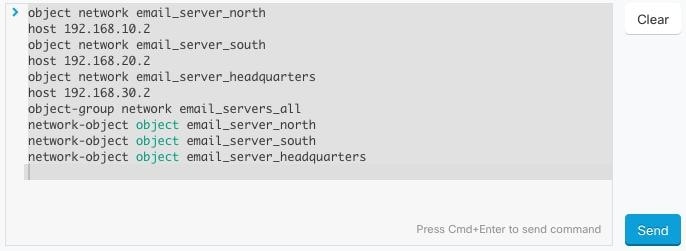Security Cloud Control Command Line Interface
Security Cloud Control provides users with a command line interface (CLI) for managing , SSH-managed, Cisco IOS devices. Users can send commands to a single device or to multiple devices simultaneously.
Using the Command Line Interface
Procedure
|
Step 1 |
In the left pane, click . |
||
|
Step 2 |
Click the Devices tab. |
||
|
Step 3 |
Use the device tabs and filter button to find the device you want to manage using the command line interface (CLI). |
||
|
Step 4 |
Select the device. |
||
|
Step 5 |
In the Device Actions pane, click >_Command Line Interface. |
||
|
Step 6 |
Click the Command Line Interface tab. |
||
|
Step 7 |
Enter your command, or commands, in the command pane and click Send. The device's response to the command(s) are displayed below in the "response pane."
|
Entering Commands in the Command Line Interface

Entering Cisco IOS commands: Security Cloud Control executes commands in User EXEC mode. You need to start a sequence of commands with enable followed by config t to execute them in Global Configuration mode.
Long Commands: If you enter a very long command, Security Cloud Control attempts to break up your command into multiple commands, so that they can all be run against the API. If Security Cloud Control is unable to determine a proper separation of your command, it will prompt you for a hint on where to break the list of commands. For example:
Error: Security Cloud Control attempted to execute a portion of this command with a length that exceeded 600 characters. You can give a hint to Security Cloud Control at where a proper command separation point is by breaking up your list of commands with an additional empty line between
them.
If you receive this error:
Procedure
|
Step 1 |
Click the command in the CLI history pane that caused error. Security Cloud Control populates the command box with the long list of commands. |
|
Step 2 |
Edit the long list of commands by entering an empty line after groups of related commands. For example, add an empty line after you define a list of network objects and add them to a group like in the example above. You may want to do this at a few different points in the list of commands. |
|
Step 3 |
Click Send. |
Work with Command History
After you send a CLI command, Security Cloud Control records that command in the history pane on the Command Line Interface page. You can rerun the commands saved in the history pane or use the commands as a template:
Procedure
|
Step 1 |
In the left pane, click page. |
||
|
Step 2 |
Click the Devices tab to locate the device. |
||
|
Step 3 |
Click the appropriate device type tab. |
||
|
Step 4 |
Click >_Command Line Interface. |
||
|
Step 5 |
Click the clock icon |
||
|
Step 6 |
Select the command in the history pane that you want to modify or resend. |
||
|
Step 7 |
Reuse the command as it is or edit it in the command pane and click Send. Security Cloud Control displays the results of the command in the response pane.
|
 to expand the history pane if it is not already expanded.
to expand the history pane if it is not already expanded.





 to see what macros already exist.
to see what macros already exist.
 .
.
 . The command is now the basis for a new CLI macro.
. The command is now the basis for a new CLI macro.



 in the CLI macro label.
in the CLI macro label.
 .
.

 . The devices affected by these changes show the status "Not Synced" in the Devices and
. The devices affected by these changes show the status "Not Synced" in the Devices and  on the details pane. Review any warnings and click
on the details pane. Review any warnings and click  in the navigation bar to view the results of the bulk deploy.
in the navigation bar to view the results of the bulk deploy.


 Feedback
Feedback